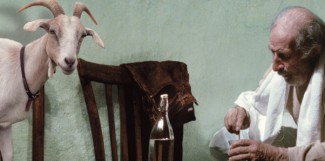Le Quattro Volte (Michelangelo Frammartino, 2010):Italy/Germany/Switzerland
Reviewed by Paula Gomez. Viewed at the AFI Film Festival 2010, Hollywood.
One can say that Le Quattro Volte is a modern muted movie. Although it does integrate sounds, its lack of vocalized dialog leaves the audience uncomfortable at first but then with a feeling of tranquility as the film progresses. It tells the simple story of an old man, a goat, a tree and the warmth of a household in a small village through the interpretation of each viewer’s internal voice.
At first, we per chance think the movie is about an old shepherd and his daily life and habits for we first see a herd of goats and the dog and old shepherd who guide them. We follow the shepherd to his home where he lies to bed alone. He goes to church, he delivers goat milk to the community and attends to his goats in a peaceful manner. Suddenly, the man dies and exactly after his death we are shown a black screen and then a shot of a goat being born. The story now focuses on the baby goat which grows up healthy and plays merrily along with its baby goat companions until, one day, the baby goat gets lost in the woods and abruptly disappears from the story, perhaps it dies too. The movie proceeds to show other scenes that reveal a thematic role of regeneration and possibly reincarnation in this artistic modern silent film.
There is a lot of silence in this work of art. There is no music, barely any dialog and predominantly diegetic sounds of the goats communicating to each other, the old man coughing, the birds singing, and the dog barking. It was a bit uncomfortable to watch for the first few minutes because on top of the lack of non-diegetic sound the scenes are a bit longer than normal and the camera displays mostly stable shots. Eventually though, we start to make up the story for ourselves instead of waiting for a narrative explanation of what the movie is about, and that’s what I really liked about this movie.
Through this technique, the visual images truly tell the story themselves. And, as an audience member, I learned to sympathize with the characters more than I would have if there had been a narration or more dialog that diverted and molded my attention to a particular type of story. Maybe sympathizing with the characters a bit more than normal was due to the fact that I had created a story in my head about what was happening and made more personal my viewing experience. Watch this movie and you’ll make up your own storyline out of beautiful depictions of an old man, a goat, a tree and the warmth of a household in a small village.
About this entry
You’re currently reading “Le Quattro Volte (Michelangelo Frammartino, 2010):Italy/Germany/Switzerland,” an entry on Student Film Reviews
- Published:
- 11.15.10 / 11pm
- Category:
- AFI Filmfest 2010, Films

No comments
Jump to comment form | comments rss [?] | trackback uri [?]